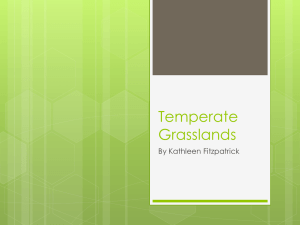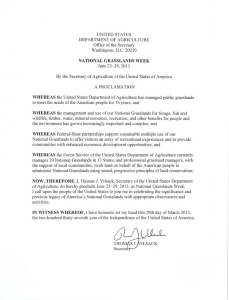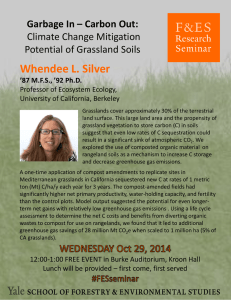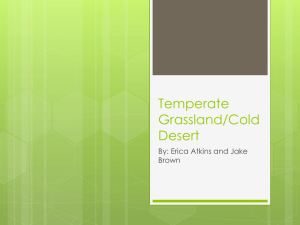THE REALIZATIONS OF THE GRASSLANDS ... IN COMPUTER PROCESSING FOR THE ...
advertisement
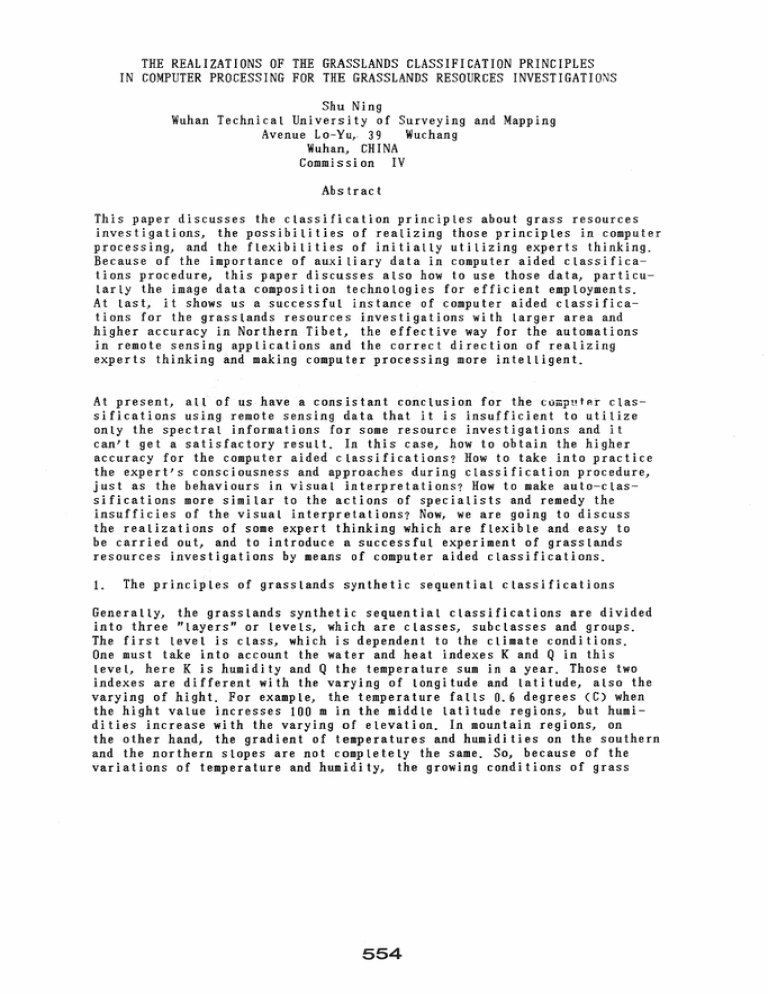
THE REALIZATIONS OF THE GRASSLANDS CLASSIFICATION PRINCIPLES
IN COMPUTER PROCESSING FOR THE GRASSLANDS RESOURCES INVESTIGATIONS
Shu Ning
Wuhan Technical University of Surveying and Mapping
Avenue Lo-Yu, 39
Wuchang
Wuhan, CHINA
Commission IV
Abstract
This paper discusses the classification principles about grass resources
investigations, the possibilities of realizing those principles in computer
processing, and the flexibilities of initially utilizing experts thinking.
Because of the importance of auxiLiary data in computer aided cLassifications procedure, this paper discusses aLso how to use those data, particuLarLy the image data composition technologies for efficient employments.
At last, it shows us a successfuL instance of computer aided classifications for the grassLands resources investigations with larger area and
higher accuracy in Northern Tibet, the effective way for the automations
in remote sensing applications and the correct direction of realizing
experts thinking and making computer processing more intelligent.
At present, all of us have a consistant conclusion for the computAt classifications using remote sensing data that it is insufficient to utilize
only the spectral informations for some resource investigations and it
can't get a satisfactory result. In this case, how to obtain the higher
accuracy for the computer aided classifications? How to take into practice
the expert's consciousness and approaches during classification procedure,
just as the behaviours in visual interpretations? How to make auto-classifications more similar to the actions of specialists and remedy the
insufficies of the visual interpretations? Now, we are going to discuss
the realizations of some expert thinking which are flexible and easy to
be carried out, and to introduce a successfuL experiment of grasslands
resources investigations by means of computer aided classifications.
1.
The principles of grasslands synthetic sequential classifications
Generally, the grasslands synthetic sequential classifications are divided
into three "layers" or levels, which are classes, subclasses and groups.
The first level is class, which is dependent to the climate conditions.
One must take into account the water and heat indexes K and Q in this
level, here K is humidity and Q the temperature sum in a year. Those two
indexes are di fferent wi th the varying of longi tude and lati tude, also the
varying of hight. For example, the temperature falls 0.6 degrees (C) when
the hight value incresses 100 m in the middle latitude regions, but humidi ties increase wi th the varying of elevation. In mountain regions, on
the other hand, the gradient of temperatures and humidities on the southern
and the northern slopes are not completely the same. So, because of the
variations of temperature and humidi ty, the growing condi tions of grass
554
and the distributions of grasslands resources in different areas are not
identical. The vertical distributions of grasslands are very distinct on
the mountains and plateaus.
General Ly, if K or Q is expressed by Y, we have
Y
=f
<L,A,H,O,S,R)
(I)
°
here, L is longi tude, A is laU tude, H represents elevation,
represents
the orientation of mountain slope, S is slope, and R is the varying
frequency of locaL retief. So,
DY = ( dY/ c3L)J<DL + ( ay/ aA)*DA + ( ay/ a-H):!<DH + ( ay/ aO»,<DO
+ (aY/;JS)*DS + (aY/dR)J<DR
(2)
In practice, when calculating the gradient of K and Q, it is assessed
according to the observation data at the meteorological stations which
are lotated at different hight in the cpncerned region.
Subclasses are second level, which have the indexes of diverse relief and
soi l condi tions, geomorphologic subareas and uni ts, as wet 1 as the soi t
conditions must be taken into account. The usual geomorphologic subareas
in voL v e p La ins, moun t a ins J h iLL s, bas ins, val ley s, etc. Wit h the va ria tions of geomorphologic and soil conditions, the distributions of grasslands
are different. This kind of variation characteristics are mainly the horizontal district distributions.
The third level surveying is carried out by the determinations of groups,
subgroups, microgroups of grasslands and the compounds of groups which are
dependent on the vegetation conditions, and need the sampling analysis
and the understanding of vegetation appearance characteristics and ground
condi lions, including superiori ty degrees, (1. e. cover percentage, hight,
amount, weight, etc.) phenologies and living strengths. Those mean the
very concrete indexes. When determining the grass superiority and the
sub-superiori ty, one can name the groups. For example, the group Kobresia-Stipa purpurea means that Kobresia is the superiori ty grass, and the
tater is the subsuperiority grass.
Above is the summary of the principle that one must follow for the grass~
Lands resources investigations, and that could be iLlustrated as fig. 1.
K,Q
~classl
--1
.
geomorphologic sUbarea~
veget.at.ion~groupi
: sub classl
_
so i L c ond i ti on
--co-n-;d....l-:-t-:-l-on---"1 "---fig. 1
2.
The realizations of the grassLands classification principles in the
computer processing procedures
In the past computer aided classifications procedures, we usually take
555
the multispectral data as objectives, and employ a certain kind of classifier. There exist a riumber of limitations when using this kind of method
which purely depends upon the separation degree of different classes in
the spectral space. It can't do any thing when there are different spectral
reflections for a same kind of ground feature, or similar spectral reflection for different kinds of ground features.
According to the general reqularities of artificial intelligences, one
must divide the train of the thoughts and the actions of some experts into
several steps when implementing the human's thinkings and behaviours by
a certain kind of machine, then realize those steps one by one. Can we
do some things like that for the computer aided classifications of grasslands? This is a very interesting and a worthy problem for us. In accordance with our studies and experiments, it is possible to realize the
grasslands classification principles in a certain extent.
The first, the water and heat indexes must be taken into consideration
for the first level of classifications. In the mountain regions, those
mainly concern the vertical distribution. When visually interpreting the
photos, we can set up a classification system for that kind of distribution according to the stereoscopies (for example, the Spacelab image
stereopairs.) and some reference documents. But how to take that into practice during the computer processing? It is necessary to use digital terrain
modle (DTM) for the logical judgements in the procedure of classifications.
It means that we can correctlydetermi.ne some kind of grasslands which is
growing in a certain elevation belt and has a certain range of spectral
reflection. So we can get higher precision of classifications by combining
the spectral informations with elevation informations (here, the first
three terms of formula (2) are taken into account and DO, DS, DR are considered as zaro.), escaping from some negative functions of spectral informations. Furthermore, if considering the slopes and their orientations
(i. e. consider the effects of DO, DS in formula (2).), those kind of data
can be derived from DTM data. The informations concerning the slopes can
also be employed in the logical processing.
Using DTM is only the indirect considerations about water and heat indexes.
Generally, when considering directly those indexes, we can calculate the
K value as following formula
r
K=
(3)
O.l)!( Q
(here r is the annual rainfall and unit is mm.)
and insert its variation gradient, in terms of the data from each meteoroLogical observatory (or station) which are located at different hight in
the concerning region. Like that, the curved surface of the water and
heat indexes is set up as the reference curved surface and controlling
paramenters for the grasslands resources investigations.
The geomorphologic conditions and soit condition must be taken into con-
556
sideration for the second level of cLassifications. It is easier to be
done when the synthetic analysis is in progress for the visuaL interpretations. Through the photo analysis, or refering to the concerning documents, or uti tizing topographic maps, one can understand the geomorphologic situations. The soil conditions could be partly understood through
the stereocopies, or by using soil theme maps, or by refering to some
documents. But when computer works, one has to tetl those informations
to i ti and train it. How to tel t i t1 One method is segmentations, for
exampLe, covering all of the mountain informations, or removing that with
the plain informations Left only_ The other is the coding in digi t, 1. e.
inputing the geomorphologic subareas an~ units informations into computer
in code form. As to the soil informations, it can be similarly obtained.
In this case, computer "knows" what background or condition there is for
some image informations. Then, the human thinking and logical judgements
can be taken into practice by some programs to make computers as the "technologists", who can correctly classify the grass groups according to the
human will in terms of the synthetic code concerning a certain geomorphologic and soil situations.
The considerations about vegetation conditions, the concrete appearance
characteristics, growth state, tiving strength and ground condi tions of
various grass groups are taken into the third level of classifications.
In terms of the results of field sampling and analysis, one can carry out
inferences, judgements and drawing for the visual interpretations. But
when using computer for the processing, it depends only upon the synthetic spectral informations offered by remote sensing, though it is not certain to depend directly upon some kind of those. The processing could base
on the extracted (or enhanced) informations. GeneralLy, the spectral
information Is is the function of the factors such as the appearence characteristics, the growing and ground si tuations of grass groups, and image
grey level data Gij (here i is Line number, j is column.) is the function
of the spectral informations Is of all of the ground features in a corresponding ground block of a pixel, which could be obtained in average value,
or determined in terms of some sensor's parameters (for example, the
optical characteristics of objective lens.) Because of the composite characteristics, the spectral informations become "blurred", and it had better
to implement some enhancement processings firstly to form a new feature
data set and then carry out the classifications. For this purpose one can
implement some transformations, enhancements or locat texture analysis
for digi tal images, for example, the caLculations of biomass index, the
principle components transformations, the calculations of local grey level
gradients, etc. We can also employ the technologies of image data compositions. For example, when some kind of remote sensing data are insufficient
in spectrum for use, or its space resolution is not higher, one needs the
use of another kind of data or the data with higher space resolution or
spectral resolution for the utilizations. Those are all possible and flexible,
and there is a instance that some one has reported a better effect obtained
by using the composition of SPOT and TM image data while the Chiria-France
Congress on the Satellite Remote Sensing and the First Utilizations of
557
SPOT Image Data held in 1986. The combining of digital image enhancements
and transformations technologies with composition technologies give us
more and lerger space for the remote sensing data processing, and show
us more possibilities to make the computer processing more intelligent.
In brief, it can be taken into practice to use the theories and consciouness of specialists during the computer aided classifications for grasslands investigations in accordance with the above analysis.
3.
The utilizations of auxilary data
It can be found out from the above mentions that one of the important
means is to utilize auxiliary data for the purpose to make the auto-classifications intelligent. For instance, the employment of DTM data can
reflect the vertical distribution regularity of grasslands, and the hori zontal distributions can be reflected by using the digitalizations of soil
type distribution maps and geomorphologic unit distribution maps. In fact,
the vizual interpretations of remote sensing images base upon a high
dimension information space which is defined as the following:
S ={ (L p, X, Y, , Z, dm, an) I L pES i; X, Y, Z ESt; dm( q) E Dm,
m = 1, 2, . . . k, q = f ( m); an E An, n = 1, 2, . . . r . }
(4)
here, 1, p are the coordinates (line, column) in image system Si, X, Y, Z
the coordinates in terrain system St, Dm is the set of different kinds of
image data (for example, the color infra-red photo, SPOT image, Landsat
image, etc.), dm(q) represents the q band information of a certain kind
dat~ (For example, dl(1) represents the seventh band information of
Landsat image. It has different value for q to different image.) An represents the different kind of auxiliary data, including some reference
documents and the ground sampling data. (For example, Al is soil type,
A2 is the agricultural division data, A3 is the agricultural meteorological data, etc.) Whi le implementing the vizual interpretation, one must
use so many informations for the synthetical analysis, the correlation
analysis and the logical inferences, etc. Here, using An information is
a very important factor. The computer processing in the past only uses a
certain kind information of Dm (only one kind of image data in most case),
and the "intelligent quotient" is not higher, so one must combine the Dm
data and An data to make computer more intelligent, and let m, n larger
than 1, if possible. But the problem now is how to use those auxiliary
data and where we use that?
Generally, there are two existance mode of auxiliary data for the computer
processing. One is direct employment with their value unchanged. Elevation
data, for example, could be of reat or integral in the DTM "fi les". The
other is to be simplified or to be the form of grey level. The simplified
form is coding. For example, coding for the soi 1 types, 1 represents red
soi 1, 1 represents sand soi t, 3 represents alkaline soi 1, etc. The grey
level form is to complete the transformations for the original data in
terms of 256 grey levels. We can get 256 levels, for example, of the hight
values in a concerning region, so the "lightest" grey level represents
the largest hight value. Because of the constraints of computer storage
capacity and storage exchanges with peripheral storages, one often uses
the simplified auxiliary data. In the DTM image, for example, one grey
value representing a elevation value needs one byte only for storage,
so economizing the computer storages,
There are two kinds of employment modes for auxiliary data in the computer
processing procedure. One is to be the fundamental data for the logicaL
processing, the other is to be direct ly used as a auxi liary "band". DTM
image, for examp le, looks like a frame of space remote sensing image, as
the different grey level represents the different elevation value. So,
it looks as the informations in a certain band of image and can reflect
the relief and the running of mountain ridges. While we use it as a "band"
for the classifications, there wilt be a kind of controlLing effects of
hights.
As to the fundamental data for the logical processing, there exist two
kinds of applications. One is to be used for segmentations, For example,
the extractions of spectraL informations in a certain elevation belt,
that depends upon DTM images. The other is to be used for dealing with
the unclassified pixe-ls in post processing. There are some "blanks" in
the result images after computer aided classifications. Those are the
pixels which computer can not "know" how to sort out. In this case, we
can classify them in terms of some auxiliary dat~ for example, the grass
growing on saline-alkali soil can be defined as Stipa-Artemisia.
Auxiliary data is the key factor in the computer aided classification
procedure and can not be utilized without digital composition technologies,
It means that the prerequisite for the use of auxiliary data is the correspondence in geometrical location of each pixel in a image with one of
auxiliary data. For the pixel (i,j), what is the corresponding elevation
value and what is the corresponding soil type? Those must be taken into
account at first when digitizing the auxiliary informations. The digitalizations of soil type distribution map must correspond with remote sensing
data window to be dealt with and one must implement the insertions and
the densifications after the digitalizations of topographic maps, In
short, one must make the Om data consistant wi th the An data in geometry.
Though it is not difficult to be taken into practice, some studies about
that must be done in detail, the methods of insertion, for example. If
we complete all of those processing, the computer aided classification
precision will be much higher.
4.
A successfuL result of application
In order to realize the grasslands classification principles during the
computer classifications, we have completed some tests and then obtained
the satisfactory results for the grasslands resources investigations of
Bange county in the Northern Tibet.
This area is of 30,000 square kilometers, At the south of this county is
Nien Qing Tang Gula mountain with the hight of more than 7,000 m. The
559
Bange town is located at the centre of this area. this county can be devided
in five natural subareas, i. e. northwest subarea wi th more saline-alkali
lands, southwest subarea with more wide valley plains and hills, northeast
subarea wi th more lakes and flat grounds, and two zones in southeast where
one is the high mountain zone (Nien Qing Tang Gula mountain), the other
is the middle and lower mountain zone. The grasslands horizontal district
distributions are very distinct in this area: from east to west, the rainfall decreases, and the grass group in the wide valleys thanges from Stipa
purpurea to Stipa purpurea-Carex moorcroftii, Kobresia-Stipa purpurea
on the upper of mountains disappears gradually; from north to south, the
terrain becomes higher and the grass group changes from Stipa purpurea
to Kobresia-rank grass. Simultaneously, the grasslands district distributions are very clear, for example, Stipa purpurea-rank grass on the wide
valley and flat ground, Stipa purpurea-Morina on the lakeside terrace,
Stipa-Artemisia+Carex moorcroftii and Stipa purpurea-Carex moorcroftii
round the saline-alkali lands, Achnatherum hookeri on the sand lands at
dry river-bed, etc.
In order to make sure that there are enough spectral informations for the
classifications, four frames of Landsat images in summer have been chosen
which cover the whole county, dated July 1985, July 1983 and September
1984 (two frames to the last). Those four frames are depart from each other
just at the neighbour of Bange town, thus one can consider those four
frames as natural areas for which one will implement the classifications
individuallY, not do that after putting together the four frames. Of
those four frames, Lasa frame is at the southeast, and is divided in two
zones in accordance of the principle on the geomorphologic subarea. Because
this county is too large for the grasslands resources investigations,
if classifying the whole data put together, the first, the calculations
are too vast and it needs too much times to do the calculations again
when getting the unsatisfactory results; the second, because of the
date 0 f i mag e f r am e s are not the s am e, an d the con t r as tis d iff ere n t aft e r
putting them together, so the spectral reflections of same ground feature
are not identical in those four image frames. In that case, the classifications will be failure; the third, according to the principle of visual
interpretation, one must treat each zone in different strategies; the
fourth, the geomorphologic subarea must be taken into account for the second
level of classifications. Consequently, it is necessary and must be
followed to implement the classifications in each zone.
As the hight difference is of more than 2,000 m, the grasslands vertical
distributions are very distinct, for example, in the east area, the verti ca I di s t r i bu ti on isS tipa purpurea--S tipa purpure a-Kobres i a--Kobres i aStipa purpurea. So we must introduce the DTM into classifications. After
digitalization of topographic maps, transform the DTM data into grey level
values for forming a "auxiliary band" in classifications.
In order to get the better results, we have chosen band 5 and band 7, not
used all of the image data. Those two bands of data concern the informations of biomass index as follows:
560
B7 - B5
Ib -
(5)
B7 + B5
Because the spectrum analysis of various typical ground features show us
that the difference of vegetation reflections between band 7 and band 5
is the greatest, and that lusher vegetati'ons grow, greater the difference
are. For this reason, those two bands are very worthy for the grasslands
investigations.
The computer classifications are carried out in the ARIES-III image processing system by using the maximum likelihood method as the classifier.
When we select the training areas for various grass groups in every natural
zone, we must simultaniously determine the prior yrobabilities for each
group according to their distribution in every natural zone. Those have
been done in terms of the photos and the sampling records from field
works; combining with the analysis about the characteristics of tones,
colors, spots of different classes and the telationships of their locations.
After trail classifications, we must adjust the training area and the
prior probability of some class when necessary. It can be seen here that
the principle of third level grasslands investigations has been taken into
practice and the vegetation conditions involving the appearence characteristics, the growth situations and the ground environments have been
considered when selecting and adjusting the training area and prior probabilities, though it is a little rough.
With the Gan-shu GraSSlands Ecology Institute as the cooperation unit,
and a lot of field surveying materials offered by that institute as the
reference data, we have determined 18 classes for classification, i.e.
kobresia-Stipa purpurea (We name it in short as K-S. The following in the
par an the sis i s the s am e mean in g. ), Stip a pur pur e a- K0 bres i a (S - K) , 1ak e s"
Stipa purpurea (S), Stipa purpurea-rank grass (S-R), Stipa purpurea-Morina
(S-M), Stipa purpurea-Carex stenophylla (S-C), uncovered rock lands, gravel
lands, Kobresia Littledalei (K), saline-alkali lands (S-L), Kobresia-rank
grass (K-R), Stipa purpurea-Carex moorcroftii (S-C), Blysmus sinocompressus
(B), Stipa-Artemisiat Carex moorcroftii (S-A), Achnatherum hookeri (A),
bush clump, and snow.
One must ensure, of course, the reasonableness of the grasslands classifications in the joining parts of the neighbouring zones, escaping from the
absoluteness.
Those processing, including the use of DTM, have taken into computer
classifications the scientific principles on the grasslands investigations,
involving the geographical concepts, and the regularities of grasslands
distributions, Here, we have seen the simplified realizations of grasslands
classification theories and the combination of the identity and the
diversity.
After the necessary post processings, one can put together the results of
561
five natural zones. If there appear some unreasonable spots at the joining
parts of the neighbouring zones, the modifications have to be done. We have
found out, when doing it, that where the considerations for joining parts
are thoughtful, the spots are joined up very well, and look very naturaL
However, some are the conjunctions of the spots which are of the similar
types of grassLands.
When the modifications are finish~d the county boundary can be put on to
get the last results. And then we can complete the statistics about the
area of every class in whole county or in each countryside.
In order to assess the last results, the experts of Gan Shu GraSSlands
Ecology Institute have examined that with alL of the record data (26 sampling points) in the field works and found that the rate of the correct
points reaches to 96.2% and the uncorrect points are of the deviations
between the similar classes, not the very large errors. For exampLe, the
grasslands which ought to belong to the class (S-K) have been classified
as that belonging to the class (K-S), and nearby the check point, there
really exists this kind of spot. So it is only the displacement and one
can say that it is a smalL deviation. All of those show us that the computer aided cLassification results are correct for the qualitative assessment and the distributions from the point of view of the entirety.
Furthermore, the statistics have been done for the quantitative assessment,
taking a countryside with the area of 600 square kilometers as the check
field and comparing the area of spots drown out when doing visual interpretations with that of the corresponding spnts resulted from computer
aided cLassification. The corre~t rate or accuracy reaches to 95.2%. That
indicates the correctness of computer aided cLassifications as viewed
from area statistics for various cLasses.
On the other hand, the efficiency of computer cLassifications for the
grasslands surveying is very evident. If implementing the visual interpretations, it needs five persons who must work on it in one year to set
up the interpreting signs, draw out the grassLands spots, transfer the
theme in mapping and calculate the areas for the grasslands investigations
of 30,000 square kilometers. However, it need only two months to fulfil
the computer processing. It resolves, consequently, the serious problem
of the vast labours for the larger area of grasslands surveying. Now, this
result is offered to the concerning planning and production department
for serving the economic constructions.
5.
Conclusion
The discusses for taking into practice the grasslands classification
theories during computer processing in first three parts, and the effects
of computer classifications for the grasslands investigations in Northern
Tibet show us that the "road" becomes wide and wide, along which we are
going for the resources surveying by using remote sensing image data.
562
We have not stopped at the dead end of the "way" that uses spectral informations only for the classifications. It is not the fantasy that the experts thinkings is employed in processing automations of remote sensing
images, and one has entered into the initial utilizations, and could do
more and more things. The important factor is that the scientists who are
engaged in remote sensing digital image processing must integrate with
the experts who work in the other fields which concern part of the problems of the former. When he is engaged in a certain job about applications
of remote sensing, he must learn a little special knowledges on that,
and understand the theories, the thinking ways and the approaches of those
experts. Then, he must consider how to create the conditions to take into
practice the expert thinking based upon the present conditions, doing that
starting at the simplified experts' thinkings. Those above have been proved by the success of computer classifications by means of auxiliary
data and the flexible computer processing technologies for 30,000 square
kilometers of grass resources investigations in Bange county in accordance
with grasslands classification theories and the requirements for three level
surveying. The realizations of experts' thinkings in the field of remote
sensing is completely possible and could reach to the satisfactory effects.
Referance:
1.
"The manual on grasslands jobs", edited by the Grasslands Department
of Gan Shu Agricultural University, 1979.
2.
Shu Ning and Guan Zhe-Qun: "The studies on the computer classifications for the grasslands investigations in Northern Tibet by using
Space lab colour infra-red images", the paper of the Congress on
Photogrammetry and Remote Sensing in Si'An, Dec, 1937.
563


